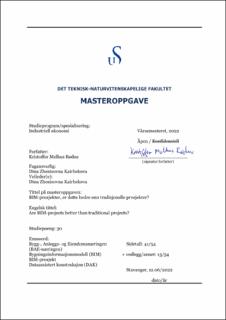| dc.contributor.advisor | Kairbekova, Dina Zhenisovna | |
| dc.contributor.author | Rødne, Kristoffer Melhus | |
| dc.date.accessioned | 2022-11-17T16:52:38Z | |
| dc.date.available | 2022-11-17T16:52:38Z | |
| dc.date.issued | 2022 | |
| dc.identifier | no.uis:inspera:106559361:46735155 | |
| dc.identifier.uri | https://hdl.handle.net/11250/3032609 | |
| dc.description.abstract | Digitaliseringen er på vei inn i BAE-næringen, og en av resultatene av denne digitaliseringen er BIM, som også blir omtalt som digital tvilling. Offentlige byggherrer har begynt å stille krav til bruk av BIM i leveranser, noe som setter et «digitaliseringspress» på hele næringen. For at man skal få størst mulig nytteverdi av BIM-leveransene kreves det kompetanseutvikling i hele næringen. Det er også viktig å utvikle relevante standarder og lover slik at leveransene i stor grad blir like, uavhengig av hvem byggherren er.
Masteroppgaven har som oppgave å besvare problemstillingen «Vil BIM-prosjekter være mer verdiskapende enn tradisjonelle prosjekter?», og for å undersøke problemstillingen er følgende forskningsspørsmål utformet:
1. Finnes det merverdi for byggherre med bruk av BIM?
2. Finnes det merverdi for entreprenører med bruk av BIM?
3. Finnes det ulemper for byggherre med bruk av BIM?
4. Finnes det ulemper for entreprenører med bruk av BIM?
For å besvare både problemstillingen og de fire forskningsspørsmålene har det blitt utført en forskningsstudie ved hjelp av kvalitativ metode, i form av litteraturstudie.
Funn fra studien viser at BIM er vesentlig enklere å forholde seg til enn det DAK er. Ved bruk av BIM får man samlet all informasjon om prosjektet på ett sted, i motsetning til tradisjonelle prosjekter hvor informasjon er spredt utover alle kanter. Det at all informasjon om prosjektet finnes på et sted vil hjelpe i både prosjekteringen og driftsfasen av bygget. Objekter vil få «personnummer» og prosjekthotellene vil være med på å skape en «bygningsjournal», på denne måten vil det være mer sporbarhet i prosjektene. Effektiviteten vil også øke med bruk av BIM, mye av grunnen til dette er at prosjekterende kun trenger å tilegne informasjon en gang til modellen. BIM vil i det hele tatt føre til at man har bedre kontroll på bygningsmassen.
Studien viser at en av de største forskjellene på BIM og DAK, er at BIM er i 3D. Det at prosjektene er i 3D vil hjelpe med visualisering av prosjektet. Aktører som er berørt av prosjektet, som brukere og kunde, kan komme med verdifull innputt i tidligfase før byggingen er startet. Visualiseringen vil også hjelpe med tverrfaglige avklaringer, slik at man unngår kollisjoner på byggeplass. Det vil også være mulig å gjøre både avanserte analyser og 4D-planlegging når man bruker BIM i prosjekter.
Oppgaven konkluderer med at selv om det kan oppfattes som en økonomisk nedside å investere i BIM-teknologi, vil oppsidene denne nye teknologien medfører være mye større enn den ene økonomiske nedsiden. | |
| dc.description.abstract | Digitalization is making its way into the AEC industry and one of the results of this digitalization is BIM, which is also referred to as digital twin. Public builders have started to demand that BIM should be part of the deliveries in their projects, which again puts a “digitalization pressure” on the entire industry. In order to harvest the benefits from a BIM delivery, the entire industry needs to develop BIM competence. It’s also important to develop relevant standards and laws in the same pacing, so the deliveries will be largely the same no matter who the client is.
This master’s thesis has the task of answering the following issue: “Will BIM-projects create more value than traditional projects?”. To investigate this issue the following research questions have been designed:
1. Are there any benefits for the client with the use of BIM?
2. Are there any benefits for the contractors with the use of BIM?
3. Are there any disadvantages for the client with the use of BIM?
4. Are there any disadvantages for the contractors with the use of BIM?
In order to answer both the issue and the four research questions, a qualitative research study has been carried out in the form of a literature study.
Findings from the study show that BIM is significantly easier to use in comparison to CAD. By using BIM on will get all the information about the project in one place, in contrast to traditional projects where information is spread “everywhere”. The easy access to all information about the project will help in both the design and operational phase of the building. Objects will receive “social security numbers” and the CDE will work as a “building journal”, this way there will be higher traceability in the projects. The efficiency will also increase when working with BIM, since the projecting teams only need to assign the information once to the model. BIM will in general lead to a better sense of control over the construction.
The study shows that one of the biggest differences between BIM and CAD is that BIM is in 3D. The fact that the projects are in 3D will help with the visualization of the project. Stakeholders in the project will be able to provide valuable input in the early phases before the construction has started. The visualization will also help with interdisciplinary clarifications which in turn will reduce the collisions on the construction site. It will also be possible to do advanced analysis and 4D planning when BIM is used in a project.
The thesis concludes that although it can be perceived as an economic downside to invest in BIM technology, the upsides of this new technology will far outweigh the one economic downside. | |
| dc.language | nob | |
| dc.publisher | uis | |
| dc.title | BIM-prosjekter, er dette bedre enn tradisjonelle prosjekter? | |
| dc.type | Master thesis | |
